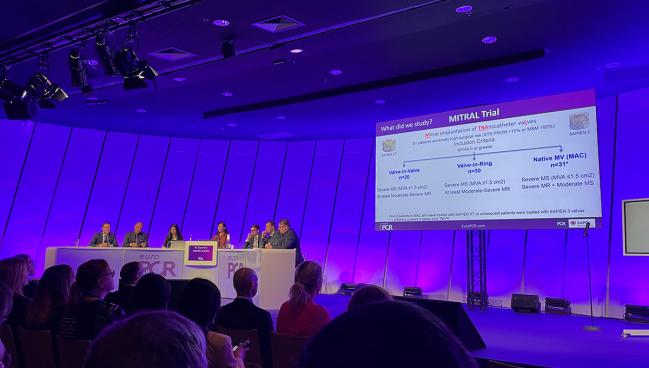MITRAL at 5 Years: TMVR for MAC, Failing Devices Shows Ongoing Impact
MITRAL II, whose design was informed by a decade of experience, is now comparing valve-in-MAC against medical therapy.

MITRAL was the first study to prospectively evaluate the safety and feasibility of mitral valve-in-valve (ViV), valve-in-ring (ViR), and valve-in-mitral annular calcification (ViMAC) procedures, using devices first approved for aortic stenosis. Initial 30-day results, released in 2017 at the TCT and American Heart Association annual meetings, were promising.
Here at EuroPCR 2023, Mayra Guerrero, MD (Mayo Clinic, Rochester, MN), summed up the full findings by saying that these TMVR procedures are “a reasonable alternative for patients who have high surgical risk and favorable anatomy.” This is important, she added, as “redo mitral surgery and surgery in severe MAC are often associated with high risk.”
For the MITRAL study, Guerrero and colleagues enrolled 91 patients at extremely high surgical risk who had severe mitral stenosis (mitral valve area ≤ 1.5 cm2) after a failed bioprosthetic valve (n = 30), after a failed surgical ring (n = 30), or with native MAC (n = 31). All underwent TMVR using a Sapien XT or Sapien 3 valve (Edwards Lifesciences).
Most of the ViV and ViMAC patients were female (63.3% and 71.0%, respectively), whereas 36.7% of the ViR group were female. Mean age ranged from 71.7 in the ViR patients up to 76.4 in the ViV patients, while mean STS scores were 8.6 for ViMAC, 8.7 for ViR, and 10.2 for ViV. The pathology for ViV and ViMAC was mostly stenosis (73.3% and 74.2%, respectively), whereas in the ViR group it was mostly regurgitation (56.7%)
Patients were assessed at 30 days and then annually thereafter through 5 years.
By 5-year follow-up, ViV patients had the lowest rates of death, mitral valve reintervention, and hemolytic anemia compared with the other two groups. “However, transcatheter valve thrombosis and endocarditis events were very low,” Guerrero pointed out.
MITRAL Trial: Outcomes at 5 Years
|
|
ViV (n = 28) |
ViR (n = 29) |
ViMAC (n = 28) |
|
All-Cause Death |
21.4% |
65.5% |
67.9% |
|
Mitral Valve Reintervention |
3.6% |
10.3% |
17.9% |
|
Hemolytic Anemia |
0 |
6.9% |
17.9% |
|
Transcatheter Valve Thrombosis |
3.6% |
0 |
7.1% |
|
Valve Endocarditis |
0 |
0 |
7.1% |
“Mean gradients remained stable,” at 6.6 mm Hg in ViV, 5.8 mm Hg in ViR, and 6.7 mm Hg in ViMAC, ViR, and ViMAC, said Guerrero, and “the vast majority had 1+ or less residual mitral regurgitation at 5 years.” Fully 100% of the surviving ViV and ViMAC patients had levels considered mild or no/trace, as did two-thirds of the ViR survivors.
“We found significant improvement in heart failure symptoms and quality of life scores, which were sustained at 5 years,” she told EuroPCR attendees. At baseline, 81% had been in NYHA class III/IV, but by 5-year follow-up, 75% were in NYHA class I/II. There also was an overall increase in median Kansas City Cardiomyopathy Questionnaire score. Looking at the three groups separately, the ViV patients saw the largest gains for both metrics.
Why Such Disparate Results?
Session moderator Fabien Praz, MD (Bern University Hospital, Switzerland), opened the discussion following Guerrero’s presentation by highlighting the “huge differences in mortality between the strategies.”
Simon Redwood, MD (St. Thomas’ Hospital, London, England), the discussant after Guerrero’s presentation, also said the discrepancy took him by surprise. “I can understand the difference in outcomes between valve-in-valve and valve-in-MAC, but what really strikes me is the outcomes of valve-in-ring are as bad as valve-in-MAC. I was trying to get my head around: why is that? Is that because their baseline ejection fraction is less? Is it because they present more with regurgitation? Are we putting valves in incomplete rings? Are we doing the procedures too late in the time course of their disease? I don’t know. What do you think?”
In reply, Guerrero said, “You just answered the question, I think. [It’s] because of all those reasons. I think these patients are different, absolutely different.”
Although they carefully selected patients, it turned out that one or two of the rings they treated were rigid, making them “not favorable” for TMVR. “They can have increased gradients or significant residual regurgitation, and we know that leaving MR behind is not good,” she explained.
Techniques have improved over time, added Guerrero, a point she elaborated on to TCTMD.
A decade ago, when she and her team did their first case in August 2013, “we did not know what we know now,” Guerrero continued. Over the years they learned that LV outflow tract (LVOT) obstruction is a strong predictor of mortality and that preemptive alcohol ablation can be protective. “All those learnings have been applied now by others in other trials,” she said.
All that knowledge has gone into the careful design of MITRAL II, for which Guerrero is principal investigator. The study is comparing patients treated with transseptal ViMAC versus controls who receive medical treatment (and who can’t undergo the intervention due to anatomical or other exclusion criteria). In the ViMAC arm, the study is allowing preemptive alcohol septal ablation, preemptive radiofrequency septal ablation, or percutaneous laceration of the anterior leaflet to reduce the risk of TMVR-induced LVOT obstruction.
“The trial is enrolling rapidly and we hope to be done with enrollment later this year,” said Guerrero.
As for the original, 5-year MITRAL results, panelist Patrizio Lancellotti, PhD (University of Liège, Belgium), pointed out that the long-term data are notable for the low rate of thrombosis and infective endocarditis. “This is huge. This is very important to mention, and it should be clearly emphasized,” he stressed.
Guerrero agreed, noting that the performance of the valve and stable gradients are also positive findings.
Caitlin E. Cox is News Editor of TCTMD and Associate Director, Editorial Content at the Cardiovascular Research Foundation. She produces the…
Read Full BioSources
Guerrero M. Outcomes of mitral valve-in-valve, valve-in-ring and valve-in-mitral annular calcification: prospective MITRAL (Mitral Implantation of TRAnscatheter vaLves) Trial final results. Presented at: EuroPCR 2023. May 17, 2023. Paris, France.
Disclosures
- Guerrero reports institutional support/research grants from Edwards Lifesciences.





Comments